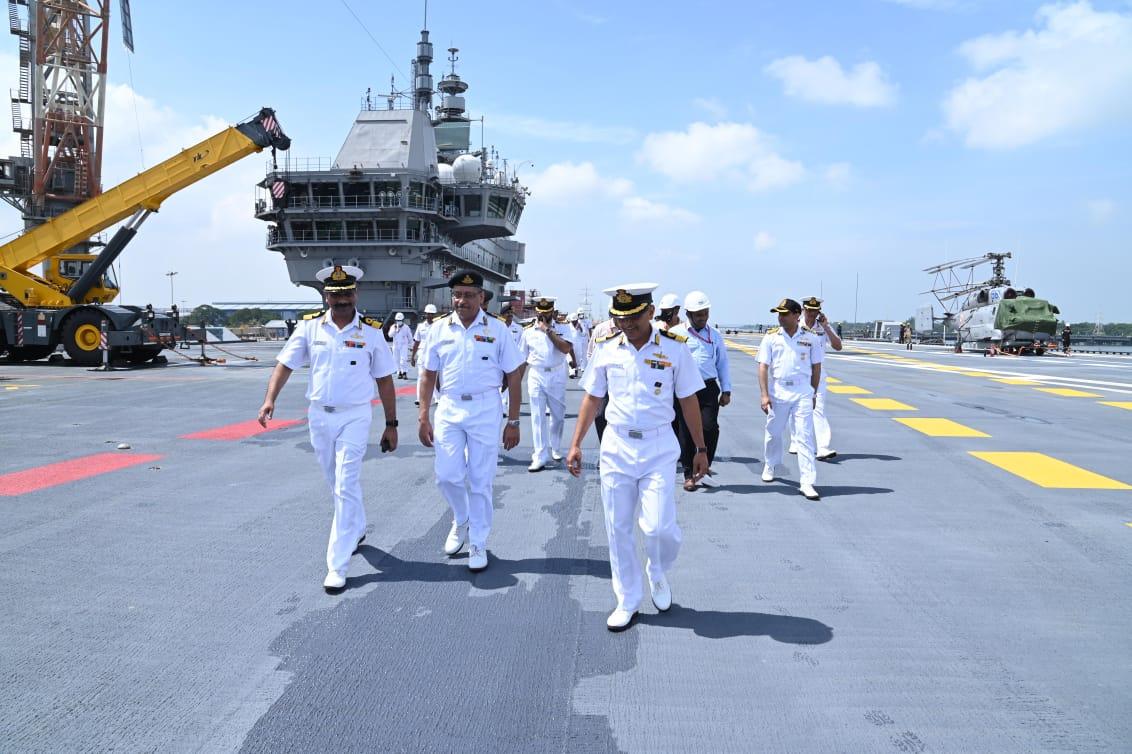India today created history and joined an elite group of countries as it commissioned the country’s first indigenous aircraft carrier (IAC-I) Vikrant, taking the delivery from its builder Cochin Shipyard Limited (CSL), Kochi. Designed by Indian Navy’s in-house Directorate of Naval Design (DND) and built by CSL, a Public Sector Shipyard under Ministry of Shipping (MoS), the carrier has been christened after her illustrious predecessor, India’s first Aircraft Carrier which played a vital role in the 1971 war.
Coinciding with the celebrations to commemorate 75th anniversary of India’s independence, the reincarnation of Vikrant is a true testimony to the country’s zeal and fervor in pursuing capability build up towards enhanced maritime security, the Indian Navy said. Marking the occasion, Cochin Shipyard Ltd in a tweet termed it as a landmark moment. Ahead of its planned commissioning the final sea trials were completed earlier this month.
Landmark Day for Atmanirbharta as Cochin Shipyard Limited (CSL) delivers the first Indigenous Aircraft Carrier to the Indian Navy, propelling India into the elite set of nations with this capability. #R11 #vikrant #india pic.twitter.com/KqbYzD3BFz
— Cochin Shipyard Limited (@cslcochin) July 28, 2022
Vikrant has been delivered to the Indian Navy by CSL following extensive user acceptance trials conducted between August 2021 and July 2022, during which ship’s performance, including hull, main propulsion, PGD, auxiliary equipment, aviation facilities, weapon and sensors as well as sea keeping and manoeuvring capabilities were proved satisfactory in accordance with trial protocols and system parameters, the Ministry of Defence said. With the completion of this aircraft carrier, India joins the elite group of countries which have the capability to build such a complex and largest warship in the world.
Delivery of Vikrant was marked by signing of acceptance documents on behalf of Indian Navy by the Commanding Officer Designate of Vikrant, representatives of Naval Headquarters and Warship Overseeing Team (Kochi) and by the Chairman and Managing Director on behalf of Cochin Shipyard Ltd., in the presence of senior officers of Indian Navy and Cochin Shipyard.
The 262-meter-long carrier has a full displacement of close to 45,000 tonnes, which is much larger and advanced than her predecessor. The ship is powered by four Gas Turbines totalling 88 MW power and has a maximum speed of 28 knots and an endurance of 7,500 nautical miles. Built at an overall cost of close to ₹ 20,000 crore, the project has been progressed in three phases of contract between MoD and CSL.
At 40,000 tonnes of displacement, the IAC-1’s reach and versatility will give more strength to the Indian Navy to secure the country’s interest in the Indian Ocean region where China continues to increase its presence and beyond. While China operates two aircraft carriers in the region, the Indian Navy so far operates INS Vikramaditya—a modified Russian Admiral Gorshkov aircraft carrier which is 45,000 tonnes.
This new warship has been designed to hold 1700 personnel, there are special cabins for accommodating women officers, and there are 2,300 compartments. This aircraft carrier is 62 meters wide, has a height of 59 meters and is 262 meters long.
Vikrant has been built with high degree of automation for machinery operation, ship navigation and survivability, and has been designed to accommodate an assortment of fixed wing and rotary aircraft. The ship would be capable of operating air wing consisting of 30 aircraft comprising of MIG-29K fighter jets, Kamov-31, MH-60R multi-role helicopters, in addition to indigenously manufactured Advanced Light Helicopters (ALH) and Light Combat Aircraft (LCA) (Navy). Using a novel aircraft-operation mode known as STOBAR (Short Take- Off but Arrested Landing), the IAC is equipped with a ski- jump for launching aircraft, and a set of ‘arrester wires’ for their recovery onboard.
The ship has large number of indigenous equipment and machinery, involving major industrial houses in the country such as Bharat Electronics Limited, Bharat Heavy Electricals Limited, GRSE, Keltron, Kirloskar, Larsen & Toubro, and Wartsila India as well as over 100 MSMEs. A major spin-off of this is the development and production of indigenous warship grade steel for the ship through a partnership between Navy, DRDO and Steel Authority of India (SAIL), which has enabled the country to become self-sufficient with respect to warship steel. Today all the warships being built in the country are being manufactured using indigenous steel.
Several design iterations, including use of 3D Virtual Reality models and advanced engineering software were used by the Directorate of Naval Design in shaping the design of the carrier. CSL had also upgraded their shipbuilding infrastructure as well as enhanced productivity skills during the building of the ship.


























